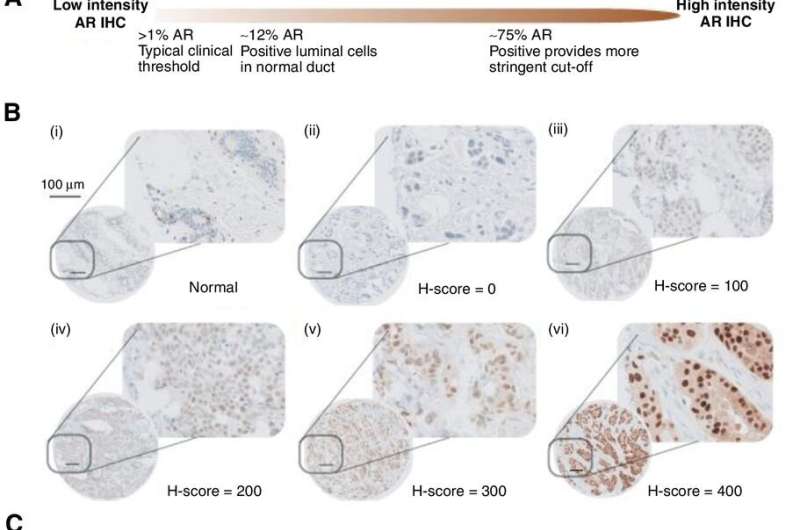Survival analysis of a TMA of primary breast cancer stained immunohistochemically for AR (n = 844). A, Graphical representation of common cut-off points in AR IHC studies with the bulk of clinical data applying an AR protein expression >1% to denote a positive stain. Normal breast ducts are reported to express approximately 12%. A more stringent cut-off point of 75% has been reported, and this was applied to the current study. B, AR protein expression was recorded as H-score (0–400) with a cut-off point of H-score = 300. Representative TMA cores of AR staining in normal breast tissue are depicted (i), alongside images of tumor staining of AR ranging in intensity from 0 to 400 (ii–vi). C, (i), Kaplan–Meier of OS univariate analysis of AR in the total population, log rank P = 0.07. (ii), Kaplan–Meier of PFS of the same population, log rank P = 0.001. (iii), Kaplan–Meier of OS univariate analysis of AR in the ER population, log rank P = 0.18. (iv), Kaplan–Meier of PFS of the same population, log rank P = 0.002. (v), Kaplan–Meier of OS univariate analysis of AR in the triple negative population, log rank P = 0.33. (vi), Kaplan–Meier of PFS of the same population, log rank P = 0.013. Credit: DOI: 10.1158/1078-0432.CCR-20-4135
A study by RCSI University of Medicine and Health Sciences has provided greater insight into the role that hormones play in the development of breast cancer in patients. The novel findings could enhance the treatment for breast cancer, assisting clinicians in optimizing individual patient care and improving overall survival rates for patients.
The study entitled "Steroid Ligands, the Forgotten Triggers of Nuclear Receptor Action; Implications for Acquired Resistance to Endocrine Therapy," is published in Clinical Cancer Research.
The hormone estrogen has been proven to have an impact on breast cancer development and there is strong evidence that other hormones such as androgens may also play a role.
According to the WHO, 2.3 million women were diagnosed with breast cancer in 2020. Excluding skin cancer, breast cancer is the most common cancer in women in Ireland. 3,600 women every year in Ireland are diagnosed with breast cancer and the majority of these receive hormone therapy.
Patients can respond differently to hormone therapy with some having a more positive response than others. This study analyzed patients' hormone profiles to provide researchers with a deeper understanding as to how breast cancer cells are affected by different hormones and why patients respond differently to hormone therapy.
The study found that hormone profiles before and after treatment play a significant role in the success of the therapy. This finding opens the door to further studies in larger patient cohorts to improve success rates associated with breast cancer treatment.
"Hormones are powerful signaling molecules that play important roles in helping our bodies function normally and respond to the world around us. For over 100 years we have known that oestrogens play a role in making breast cancers grow and many of the common drugs prescribed to treat it are to reduce the amount these hormones or to block their action. Unfortunately, not all patients will respond to these drugs and we need a better way to determine response to this type of therapy" said Dr. Marie McIlroy, the study's senior author and Lecturer, Endocrine Oncology Research, Department of Surgery, RCSI.
"By looking at each individual person's tumor hormone levels we get a better idea of the differences between people who respond well to hormone treatment and those who do not, potentially enabling us to make more informed decisions on treatment options for patients."
More information: Rachel Bleach et al, Steroid Ligands, the Forgotten Triggers of Nuclear Receptor Action; Implications for Acquired Resistance to Endocrine Therapy, Clinical Cancer Research (2021). DOI: 10.1158/1078-0432.CCR-20-4135
Journal information: Clinical Cancer Research
Provided by RCSI University of Medicine and Health Sciences























